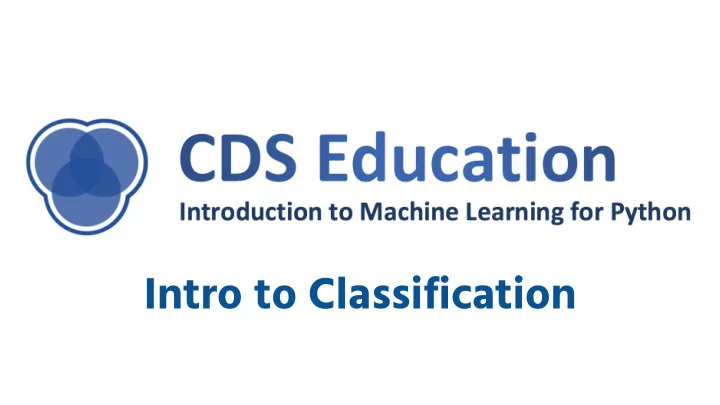

Intro to Classification
Sanity Check ➢ Project A Did everyone turn in their project? ○ Any concern or questions? ○ ➢ Project B released today Linear Regression ○ KNN Classification ○
Question: Last week we talked about regression. What is supervised learning? What is regression?
Conditions for Linear Regression ● Data should be numerical and linear ● Residuals from the model should be random ○ Heteroscedasticity ● Check for outliers Source
Review: Least Squares Error We define our error as follows: theoretical observed We call this Least Squares Error . Sum of squared vertical distance between observed and theoretical values.
Model ”Goodness of Fit” Common metric is called R 2 . ● We compare our model to a benchmark model ○ Predict the mean y value, no matter what the x i ’s are ● SST = least-squares error for benchmark ● SSE = least-squares error for our model ● R 2 = 1 - SSE/SST Source
Non-Linear Regression ● PolynomialFeatures function generates different polynomial degrees (x 2 , x 3 , …) ● Curve_fit function can match your function to the model Source
Intro to Classification ● “What species is this?” ● “How would consumers rate this restaurant?” ● “Which Hogwarts House do I belong to?” ● “Am I going to pass this class?” Source
The Bayesian Classifier The ideal classifier: a theoretical classifier with the highest accuracy ● Picks the class with the highest conditional probability for each point ● Assumes conditional distribution is known ● Exists only in theory! ● ○ A conceptual Golden Standard
Decision Boundary ● The decision boundary partitions the outcome space ● Classification algorithm you should use differs depending on whether the data is or is not linearly separable Source
k-Nearest Neighbors (KNN) Most of my friends Easy to interpret around me got an A on A this test. Maybe I got Fast calculation an A as well then. No prior A A assumptions ? C A A Good for coarse A analysis A A A A B B C
Multi-Class Classification Classifying instances into three classes or more Source
One-vs-All ● Train a single classifier per class ● All samples of that class classified as positive, all other samples as negative
KNN How does it work? Define a k value (in this case k = 3) Pick a point to predict (blue star) Count the number of closest points Increase the radius until the number of points within the radius adds up to 3 Predict the blue star to be a red circle! Source
Demo
Question: What defines a good k value?
KNN The k value you use has a relationship to the fit of the model. Source
Overfitting When the model corresponds too closely to training data and then isn't transferable to other data. Can fix by: ● Splitting data into training and validation sets ● Decreasing model complexity Source
Confusion Matrix
Sensitivity = True Positive / Sensitivity (True Positive + False Negative) Also called True Positive Rate . How many positives are correctly identified as positives? Optimize for: Airport security ● Initial diagnosis of fatal disease ● Source
Specificity = True Negative / Specificity (True Negative + False Positive) Also called True Negative Rate . How many negatives are correctly identified as negative?
Question: Name some examples of situations where you’d want to have a high specificity.
Specificity = True Negative / Specificity (True Negative + False Positive) Also called True Negative Rate . How many negatives are correctly identified as negative? Optimize for: Testing for a disease that has a ● risky treatment DNA tests for a death penalty case ● Source
Other Important Measures ● Overall accuracy - proportion of Accuracy = (True Positive + True Negative)/Total correct predictions Error Rate = ● Overall error rate - proportion of (False Positive + False Negative) /Total incorrect predictions ● Precision - proportion of correct Precision = True Positive positive predictions among all /(True Positive + False Positive) positive predictions
Example Given this confusion matrix, what is the: Specificity? ● Sensitivity? ● Overall error rate? ● 146 32 Overall accuracy? ● Precision? ● 21 590
Threshold Where between 0 and 1 do we draw the line? ● P(x) below threshold: predict 0 ● P(x) above threshold: predict 1 Source
Thresholds Matter (A Lot!) What happens to the specificity when you have a Low threshold? ● ○ Sensitivity increases, specificity decreases High threshold? ● ○ Sensitivity decreases, specificity increases Source
ROC Curve R eceiver O perating C haracteristic Visualization of trade-off ● Each point corresponds to a ● specific threshold value
Area Under Curve AUC = ∫ ROC curve Always between 0.5 and 1. Interpretation: 0.5: Worst possible model ● 1: Perfect model ●
Coming Up Your problem set: Start working on Project Part B Next week: More classifiers (SVM!) See you then!
Recommend
More recommend